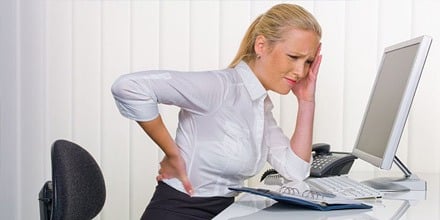
Reduce Your Back Pain in Just 1 Hour
If you spend most of your day commuting to the office and then sitting at your desk, a fast, easy way to start your new year off healthier is to do some of your desk work standing up.
Sitting a little less each day can reap big health benefits
Sitting too much at work has become so detrimental to our health that in their annual meeting in 2013, the American Medical Association (AMA) formally recommended employers adopt solutions for their employees to help them stand up and move around more at the office.
In order to live a comfortable life in retirement, millions of Americans sacrifice now by putting money into their 401K and other retirement plans. One question to consider is: What good is it to have this nest egg when my hips and back hurt so badly that I can’t enjoy it? Like a financial plan, ensuring a future without low back pain and activity restrictions requires regular and consistent diligence. This article outlines an exercise program that is simple and easily done at home – without requiring exercise equipment or access to a gym or fitness facility.
Exercise Program to Stretch the Back and Legs
The following are some stretches that aid in pain relief by helping take stress off the low back and hips and may greatly reduce the advancement of arthritis in the spine. These back exercises should be performed in a pain free manner. If pain is experienced, it is best to discontinue the exercises and consider being evaluated by a licensed chiropractor that specializes in treatment of the spine. If you already have lower back pain or any other health condition, it is advisable to first be evaluated by a physician and, as appropriate, receive guidance on how to do the following exercises by a spine specialist.
Piriformis Muscle Stretching Exercise
The piriformis muscle runs from the back of the femur (thigh bone) to the sacrum (base of the spine). Tightness in this muscle has been linked to sacroiliac joint dysfunction and even sciatica-type pain along the sciatic nerve. To stretch the piriformis, lie on your back and cross the involved leg over the other. With both knees bent, place both hands together under the knee of the other leg (the lower leg), and gently pull the bottom leg toward your chest and hold both thighs closely until a stretch is felt in the buttock area. (Figure 1)
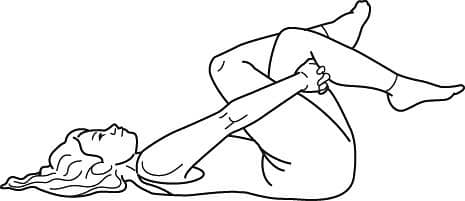
Figure 1: Piriformis muscle stretching exercise
• Hold 30 seconds
• Repeat
• 1-2 times per day
Psoas Major Muscle Stretching Exercise
The Psoas Major muscle attaches to the front portion of the lower spine (from thoracic segment 12 through lumbar segment 5) and can greatly limit low back mobility when tight. It often is one of the sources of low back pain in patients who have difficulty standing for extended periods or kneeling on both knees. This muscle can be stretched in a half kneeling position (kneeling on one knee). Rotate the leg outward and tighten the gluteal muscles on the side you’re stretching. Next, lean forward through the hip joint rather then bending through the lumbar spine. A stretch should be felt in the front of the hip that the patient is kneeling on. (Figure 2)
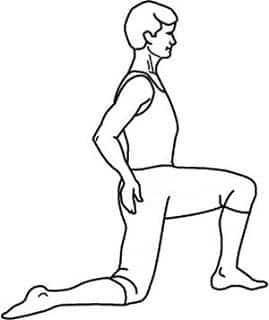
Figure 2: Psoas Major muscle stretching exercise
• Hold 30 seconds
• Repeat
• 1-2 times per day
Hamstring Muscle Stretching Exercise
The hamstrings run from the back of the ishial tuberosity (sit bones) to just below the back of the knees. They are responsible for bending the knee and assisting the gluteal muscles to extend the hip. These muscles are very important to stretch because, when tight, they make it nearly impossible to sit up straight. People who do not sit with an erect posture run the risk of early onset of degenerative disc disease and other back problems. Tight hamstring muscles are closely associated with low back pain. One way to gently stretch hamstring muscles is to lie on the back and grasp the leg behind the knee with the hip flexed to 90 degrees and the knee bent. Attempt to straighten the knee with the toes pointed back toward you. (Figure 3)
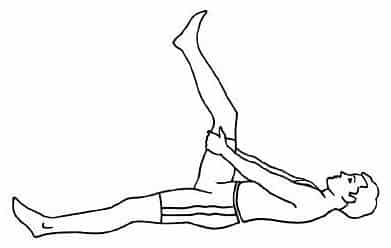
Figure 3: Hamstring muscle stretching exercise
• Hold 30 seconds
• Repeat
• 1-2 times per day
Strengthening Exercise Program for Low Back Pain Relief
The next few exercises are examples of some basic stabilization exercises that aid in low back pain relief. Having strong midline support is critical to decreasing the stresses placed upon the lumbar spine (lower back) and pelvis. It should be noted, however, that often muscles that appear to be weak may actually be inhibited by an antagonist muscle (muscle on the opposite side of the joint) or by faulty lumbar facet joint mechanics. Generally, an inhibited muscle will not respond to resistance training. Therefore, if low back pain or hip pain is being experienced, it is important to first see a chiropractor in order to screen for muscle inhibition. Attempting to strengthen an inhibited muscle may cause a substitution pattern that only reinforces a painful movement pattern. In general, it is advisable to see a spine specialist who specializes in back pain prior to beginning any exercise program.
In addition, unlike stretching exercises, it is important to take a few days off per week from strengthening exercises to allow the body to rest and build strong muscles. A chiropractor or licensed physical therapist can help design a strengthening exercise program to fit an individual’s specific needs and help with pain relief. In general, a spinal stabilization exercise program usually includes strengthening the abdominal muscles in the front and the gluteal muscles in the back.
Transversus Abdominis Muscle Strengthening (Abdominal Exercise)
Many people think of performing abdominal crunches or situps to strengthen the abdominal muscles. While “six pack abs” look nice to some, it is more important to work the Transversus Abdominis (TVA) through abdominal exercise to achieve spinal stability. When retraining the TVA, it is important to maintain a neutral lumbar spine (don’t try pushing the back all the way into the floor). The back is most often in a neutral spine position, so it makes less sense to strengthen the back in a flexed or extended position. Lie on one’s back with the knees bent. Knees and feet should be shoulder width apart. Draw the belly button toward the spine while maintaining a neutral spine. Upon exhalation, reach toward the ceiling as if trying to grab a trapeze overhead. Then raise the head and shoulders off the floor, just to the point where the shoulder blades are barely touching the floor, and hold 1-2 seconds. Inhale upon return and repeat at the end of the next exhalation. Continue until it is not possible to maintain a neutral spine or when fatigued. (See Figure 4)
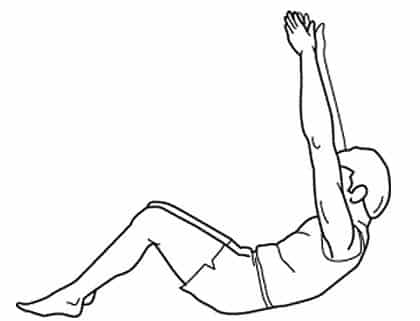
Figure 4: Transversus Abdominis muscle strengthening
• Hold 1-2 seconds
• Repeat until fatigued
• 1 time per day
• 4-5 days per week
Gluteus Maximus Muscle Strengthening (Buttock Exercise)
To strengthen this muscle, lie on your stomach with your hips and legs off the end of a table or bench. Tighten the buttock on one side and extend the leg up toward the ceiling while maintaining a neutral spine. Movements should be slow. Initially, it is common to only be able to perform a few repetitions at a time. (See Figure 5)
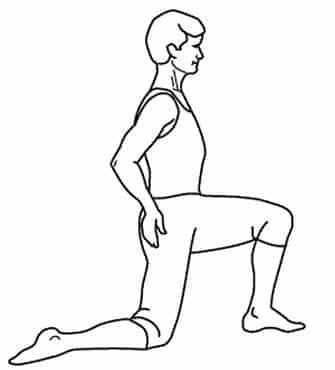
Figure 5: Gluteus Maximus muscle strengthening
• Hold 5 seconds
• 4-10 repetitions per side
• 1 time per day
• 4-5 days per week
Gluteus Medius Muscle Strengthening (Hip Abductor Exercise)
This muscle (the hip abductor) is used to raise the leg laterally at the hip and also supports the pelvis when standing on one leg (single leg stance). If this muscle is weak or inhibited, the opposite pelvis will drop when single leg stance is performed. Functionally, single leg stance is performed whenever someone walks. A weak gluteus medius will result in the opposite hip dropping during the gait cycle and can cause an increase in low back pain and hip pain with walking. To strengthen the gluteus medius, lie on your side with your back against the wall. Draw your belly button in while maintaining a neutral spine. Raise the upper leg with the toes slightly pointed toward the ceiling and the heel maintaining contact with the wall. Perform slowly with a 2 second hold at the top. (See Figure 6)
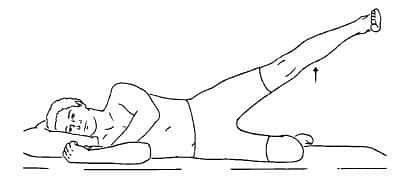
Figure 6: Hip Abductor Exercise
• 10 repetitions per side
• 1 time per day
• 4-5 days per week
Optimizing Exercise Programs for Pain Relief. Should You Exercise Through Pain?
As with all exercise programs, these low back stretching and strengthening exercises should be preceded by warm-up and followed by cool-down activities, such as walking and gentle stretching. It is advisable to always consult a medical professional prior to beginning any exercise program, and if pain, such as low back pain or leg pain, is felt or aggravated, it is best to consult a doctor that specializes in these types of exercise programs.
Backed by an easy-to-replicate study
In a recent study, participants were able to significantly reduce back and neck pain and improve their mood by sitting just 66 minutes fewer each day. Participants in the study were sedentary office workers of average health, height, and weight. Researchers provided them with a device that allowed them to sit or stand at their desks throughout the day during the 7 week duration of the study. They were given free choice to sit or stand as much—or as little—as they felt comfortable. The group ended up sitting around one hour less each day—enough to realize statistically significant health benefits.
The necessary equipment is easy to find; a quick online search will give you hundreds of ideas for sit-to-stand devices for your desk.
Decrease in back and neck pain
In that relatively short period of 7 weeks, the office workers reported a statistically significant reduction in upper back and neck pain. They also reported feeling generally more comfortable, experiencing less lower back pain and less wrist pain.
Simple Office Chair Stretch

Fig 3: Office chair stretch – clasp your hands behind you

Fig 4: Office chair stretch – exhale, gently lean the head, and extend the front of the body
The continuous forward leaning posture many people adopt while sitting in an office chair has serious consequences for more than just the back and spinal column. It also places a burden on the internal organ systems, digestive system, and lungs when the front of the body is compressed by hunching forward for long periods of time.
Stretch breaks are absolutely essential to open up the front of the body and create renewed tissue circulation and joint mobility. The Reverse Arch Stretch was specifically developed to quickly counteract negative spinal, shoulder, wrist, finger, and organ system effects from forward hunching computer posture. The stretch only takes a few seconds to do and has an immediate benefit anyone can feel. As with any stretch, when doing the reverse arch stretch it is important to take your time and listen to your body while doing it. If you feel any pain or discomfort, stop doing the stretch. Always listen to the signals your body sends you. Practice makes perfect, so even if the stretch feels a bit awkward at first it will soon become easier to do and a welcome part of the work day routine.
Reverse Arch Stretch
Move to the front of the chair and if possible interlace your fingers behind the back and feel the palms touching each other. There will be a stretch feeling in the front of the chest and shoulders when doing this. (If bringing the palms together is too difficult, an easier alternative is to clasp the hands together using just the fingers and not the palms). See Figure 3.
Once the proper hand position has been established, take a deep breath in and let the shoulders move even further backwards, letting the head fall back as well (this opens up the front of the neck).
Now exhale all the air, feeling the front of your body open up as you extend backwards. See Figure 4.
Hold this position for a few deep breaths if it feels comfortable to do so.
To get out of the stretch SLOWLY bring your head back up to ensure that you do not strain your neck.
Only stretch back as much as you’re comfortable with. Over time you’ll feel that you are able to get deeper into this stretch, extending back even further with minimal effort. Doing the Reverse Arch Stretch while standing provides additional opening benefit to the buttock and pelvis as well. Ideally, it is best to practice the stretch both while seated in an office chair and while standing. The ‘opening’ feeling you’ll experience in your body afterwards is the direct result of increased blood flow, reduced organ system tension, enhanced spinal motion, and relaxed muscle tone that the Reverse Arch Stretch creates. As with the other techniques discussed in this article, this simple office chair stretch is effective, easy to do, and easily empowers you to take better care of yourself. In addition to this stretch, it is best to stand and walk around every half hour. A brisk walk helps get the circulation going, bringing oxygen and nourishment throughout the structures of the body.
Increase in emotional well being
Study participants reported decreased fatigue, tension, confusion, and depression—all gained by decreasing their sitting time by just 66 minutes per day. Specifically, 87% reported feeling more comfortable and more energized when they were alternating between standing and sitting. Additionally,• 75% felt healthier
- 71% felt more focused
- 66% felt more productive
- 62% felt happier
- 33% felt less stressed.
The Takeaway
In the developed world, our lifestyles are becoming increasingly sedentary. It is encouraging to know that sitting just an hour less a day can help reduce our neck and back pain and boost our mood. This may be the easiest healthy living suggestion ever. As the buzz over sitting too much continues to build, maybe it’s time to devise a way you can get more standing time in your day. How will sitting less help you?
Dr. Steven Becker lives and works in West LA and frequently sees patients from the surrounding neighborhoods of Beverly Hills, Century City and Culver City. He specializes in the treatment of spinal stenosis, sciatica and coccydynia. Please feel free to call with any questions or comments (310)277-8822. Reprinted with permission.


